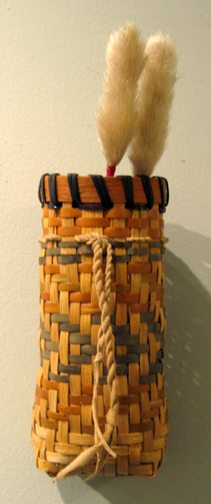Blowgun
Blowgun is a simple ranged weapon consisting of a long narrow tube for shooting light projectiles or darts. The operator breathes in and exhales out through the tube, propelling the dart forward. Blowguns are used by indigenous peoples in Southeast Asia, the Amazon and Guiana regions of South America, and Central America for hunting small game and birds, as well as for recreation and competition.
History[edit | edit source]
The history of the blowgun dates back thousands of years, with evidence of their use in various cultures around the world. In ancient times, blowguns were crafted from materials readily available in the environment, such as bamboo, cane, or reeds. These weapons were often used for hunting small animals and birds, utilizing the element of surprise and the skill of the hunter. In some cultures, the tips of the darts were coated with natural poisons to ensure the lethality of the shot.
Design and Operation[edit | edit source]
A typical blowgun consists of a tube, which can range in length from about 0.5 meters for short-range models to over 3 meters for those intended for long-range use. The interior of the tube is smooth and precisely straight to allow the projectile to travel without obstruction. Darts can be made from various materials, including wood, bone, and metal, often with a pointed tip and a stabilizing tail made from plant fibers or feathers.
The effectiveness of a blowgun is largely determined by the diameter of the tube, the length of the tube, the physical condition of the user, and the design of the projectile. The user's lung capacity and ability to exhale forcefully also play a critical role in the velocity and accuracy of the shot.
Cultural Significance[edit | edit source]
In many cultures, the blowgun is more than just a weapon; it is a symbol of survival and craftsmanship. Among the indigenous tribes of the Amazon, for example, blowguns are deeply integrated into the culture, with each tribe having its unique designs, crafting techniques, and rituals associated with their use. The skills required to make and use blowguns are passed down through generations, preserving the tradition and knowledge of the people.
Modern Use[edit | edit source]
Today, blowguns are used for various purposes, including hunting, sport, and recreation. In some regions, traditional hunting practices with blowguns continue, while in other areas, blowgun competitions are held, testing the accuracy and skill of the participants. The modern sport of blowgun shooting has even led to the establishment of associations and clubs dedicated to the practice and promotion of blowgun shooting as a competitive sport.
Legal Status[edit | edit source]
The legal status of blowguns varies from country to country. In some places, they are considered weapons and are subject to specific regulations or outright bans. In other regions, they are treated as sporting equipment and are legal to own and use. It is important for individuals to be aware of and comply with the laws and regulations regarding blowguns in their jurisdiction.
See Also[edit | edit source]
Transform your life with W8MD's budget GLP1 injections from $125 and up biweekly
W8MD offers a medical weight loss program NYC and a clinic to lose weight in Philadelphia. Our W8MD's physician supervised medical weight loss centers in NYC provides expert medical guidance, and offers telemedicine options for convenience.
Why choose W8MD?
- Comprehensive care with FDA-approved weight loss medications including:
- loss injections in NYC both generic and brand names:
- weight loss medications including Phentermine, Qsymia, Contrave, Diethylpropion etc.
- Accept most insurances for visits or discounted self pay cost.
- Generic weight loss injections starting from just $125.00 for the starting dose
- In person weight loss NYC and telemedicine medical weight loss options in New York city available
Book Your Appointment
Start your NYC weight loss journey today at our NYC medical weight loss, and Philadelphia and visit Philadelphia medical weight loss Call (718)946-5500 for NY and 215 676 2334 for PA
Search WikiMD
Ad.Tired of being Overweight? Try W8MD's NYC physician weight loss.
Semaglutide (Ozempic / Wegovy and Tirzepatide (Mounjaro / Zepbound) available. Call 718 946 5500.
Advertise on WikiMD
|
WikiMD's Wellness Encyclopedia |
| Let Food Be Thy Medicine Medicine Thy Food - Hippocrates |
Translate this page: - East Asian
中文,
日本,
한국어,
South Asian
हिन्दी,
தமிழ்,
తెలుగు,
Urdu,
ಕನ್ನಡ,
Southeast Asian
Indonesian,
Vietnamese,
Thai,
မြန်မာဘာသာ,
বাংলা
European
español,
Deutsch,
français,
Greek,
português do Brasil,
polski,
română,
русский,
Nederlands,
norsk,
svenska,
suomi,
Italian
Middle Eastern & African
عربى,
Turkish,
Persian,
Hebrew,
Afrikaans,
isiZulu,
Kiswahili,
Other
Bulgarian,
Hungarian,
Czech,
Swedish,
മലയാളം,
मराठी,
ਪੰਜਾਬੀ,
ગુજરાતી,
Portuguese,
Ukrainian
Medical Disclaimer: WikiMD is not a substitute for professional medical advice. The information on WikiMD is provided as an information resource only, may be incorrect, outdated or misleading, and is not to be used or relied on for any diagnostic or treatment purposes. Please consult your health care provider before making any healthcare decisions or for guidance about a specific medical condition. WikiMD expressly disclaims responsibility, and shall have no liability, for any damages, loss, injury, or liability whatsoever suffered as a result of your reliance on the information contained in this site. By visiting this site you agree to the foregoing terms and conditions, which may from time to time be changed or supplemented by WikiMD. If you do not agree to the foregoing terms and conditions, you should not enter or use this site. See full disclaimer.
Credits:Most images are courtesy of Wikimedia commons, and templates, categories Wikipedia, licensed under CC BY SA or similar.
Contributors: Prab R. Tumpati, MD







